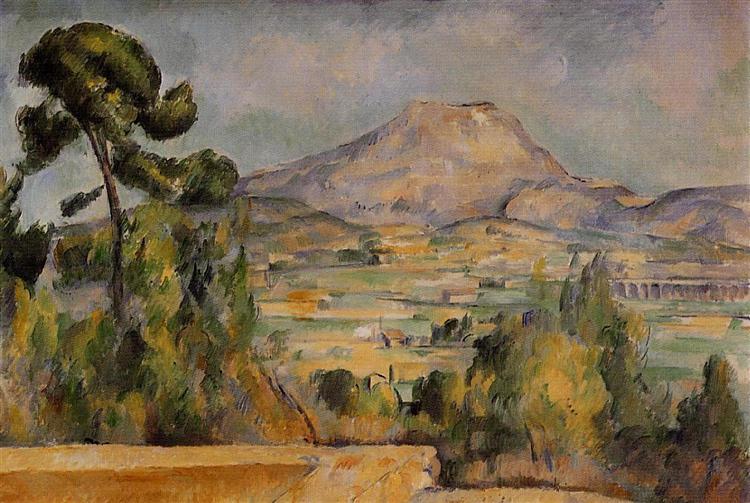Tanım
1890'da oluşturulan Paul Cézanne'nin "Mont Sainte-Victoire" çalışması, modern sanatın gelişiminin ve yazarının ayırt edici tarzının, postimpresyonizm ve dolayısıyla birçok sanatsal para öncüsü olarak kabul edilen temel bir ifadedir. devam ederdi. Aix-en-Provence'ın yerlisi olan Cézanne, kendi bölgesinin manzarası ve topografyası ile samimi bir bağ geliştirdi ve bu resim, amblematik dağın çalışmalarına hakim olan çoklu temsillerinden biridir.
Görsel olarak, resim formların saflaştırılması ve bileşimin karmaşıklığı ile karakterizedir. Cézanne, doğal yapıların, manzarayı neredeyse heykelsi bir biçimde parçalayan prizmalar ve planlar aracılığıyla yeniden yorumlandığı geometrik bir yaklaşım kullanıyor. "Mont Sainte-Victoire" de dağ, sadece bir zemin olarak değil, işin canlı çekirdeği olarak görkemli bir şekilde arka planda duruyor. Formların gruplandırılma şekli, izleyiciyi sadece dağı değil, aynı zamanda ön düzlemle koruduğu diyalogu da düşünmeye davet eden peyzaj yapısının derin bir anlayışını ortaya koyar.
Renkler bu resmin bir başka önemli boyutudur. Cézanne, Mavi, Yeşil ve Sarch tonlarının hafif bir ortam ve Güney Fransa'nın karakteristik bir atmosferi yaratmak için iç içe olduğu sınırlı ama canlı bir palet kullanır. Bu renklerin etkileşimi, izleyiciyi çevreleyen görsel bir kumaş oluşturur, katmanlardaki düzenine ek olarak ışığı yansıtır, böylece boşluk yeniden tanımlanır. Gevşek ve görünür fırça darbeleri, rengi dokunuşlarda uygulama tekniğini tercih eden Cézanne'nin resimsel sürecine tanıklık eder, bu da çalışmanın yüzeyine elle tutulur bir doku ekler.
Karakterlerin ve günlük yaşamın yaygın olduğu ilk eserlerinin aksine, bu kompozisyonda insan figürü yoktur. Bu yokluk, Cézanne'nin iletmeyi başardığı kalıcılık ve gerçeklik duygusunu vurgulayarak manzaranın anıtsallığını arttırır. Dağın, ön plandaki ağaçlar ve ufukta uzanan tarlalar gibi onu çevreleyen doğal unsurları yineleme şekli, insan ve daha fazla tefekküre yönelik doğa arasında bir ilişkiyi yapılandırmaya hizmet etmek ve anlatıya doğru.
İlginç olan, bu resmin Cézanne'nin tam çalışmasında olduğu bağlam. Bu süre zarfında, sanatçı, sadece temsilinden ziyade manzaranın görsel ve duygusal özünü yakalamak için sürekli bir arama içindeydi. "Mont Sainte-Victoire", bir anlamda, becerilerinin bir özetidir: hem tabloya inanç beyanı hem de doğa çalışmasıdır. Cézanne sadece gördüklerini çoğaltmakla değil, gerçekliğin altında yatan doğasını renk ve şekil yoluyla ifade etmekle de ilgileniyordu.
Sanat panoramasında, "Mont Sainte-Victoire", Cézanne'nin doğrudan etkilediği bir stil olan Kübizm'in öncüsü olarak görülebilir. Bu çalışmada kanıtlanan perspektifin formunun parçalanması ve keşfi, Pablo Picasso ve Georges Braque gibi daha sonraki sanatçıların çalışmalarında şiddetle yankılanacaktır. Böylece, bu resim sadece Cézanne'nin kariyerinde bir kilometre taşı değil, aynı zamanda sanatsal olarak konuşan modernitenin itici gücüdür.
"Mont Sainte-Victoire" diye düşünürken, anlamını sadece görsel bir temsil olarak değil, Cézanne'in yaratıcı sürecinin derinleştirilmiş bir tezahürü olarak tanımak önemlidir. Hayatındaki sürekli deniz feneri olan dağ, fiziksel formunu, her bir fırça darbesinin onu çevreleyen dünyayla ilişkisinin bir fısıltısı olduğu bir arama ve vahiy sembolü haline getirmek için aşar. Bu çalışma ile Cézanne bizi manzaranın yüzeyinin ötesine taşıyor ve sanat ve doğanın gerçek ve dönüştürücü bir deneyime dönüştüğü bir alana giriyor.
KUADROS ©, duvarınızda ünlü bir boya.
Profesyonel sanatçıların kalitesi ve ayırt edici mührü ile el yapımı yağlı boya boya tablolar KUADROS ©.
Memnuniyet garantisi ile resim reprodüksiyon hizmeti. Resminizin kopyasından tamamen memnun değilseniz, paranızı%100 iade ederiz.

